Template:DRM databases
By Repertory
Secular Vocal and Folksong Repertories
Bodleian Library Broadside Ballads Catalogue
Website: Bodleian Broadside Ballads Project
The Bodleian broadside ballads project, which was developed mainly from 1995 to 2000, spans the history of the genre. A search form enables users to access the allegro Catalogue of Ballads by sheet or ballad title, first line, and tune name as well as publisher, date, and other parameters.
César: French Theatrical Database
Website: César
The Calendrier électronique des spectacles sour l'ancien régime et sous la révolution, originally developed at Oxford Brookes University by Barry Russell and in Toronto by David Trott but expanded to include other collaborators after their deaths, offers a searchable database of personnel (broadly defined), titles, dates, venues, and pertinent treatises on the French theater of the seventeenth and eighteenth centuries. Among its most unusual holdings are its calendar of police reports from the revolutionary period.
CLORI: Archive of the Italian Cantata
Website: http://www.cantataitaliana.it/
CLORI, which hosts cantata texts, manuscript source citations, and images that show characteristics of handwriting, has a number of sponsors and collaborators including the Italian Musicological Society (SIM in Italian), the University of Rome (Tor Vergata), the Italian Institute for Music History (IISM), and RISM. The project is headed by Teresa M. Gialdroni. Click the "ricerca" button to go to the search form.
Deutsches Volksliedarchiv (German Folksong Archive)
Website: Deutsches Volksliedarchiv
The German Folk Music Archive (in German) has evolved over a century (to 2014) as a central clearing house for folk songs from German-speaking lands. It contains several component parts including (1) a Lieder Lexicon in which folksong texts are listed alphabetically; (2) a listing of specific projects, mainly those with a critical dimension; and (3) a popular Song Lexicon.
EASMUS: Early American Secular Music and its European Sources
Website: EASMUS
This extensive canvas of secular music in the American colonies and early states (1589-1839) consists of a series of indices (titles, first lines, musical incipits [by scale degree], stressed notes, et al.). It was developed over the 1970s and 80s by Kate Van Winkle Keller, Robert Keller, Carolyn Rabson, Raoul F. Camus, and Susan Cifaldi. The contents include ballad operas, band music, song sheets, theater works, and the names of tunes played by musical clocks.
English Broadside Ballad Archive
Website: English Broadside Ballad Archive
Six thousand English broadside ballads, mainly from the seventeenth century, are included in this comprehensive project extending to related artistic and cultural phenomena. It development continues through 2016.
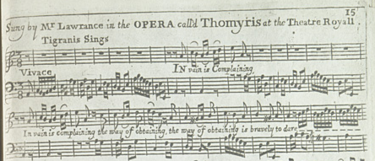
Goldberg Stiftung: Loire Valley Chanson Sources
Website: Chansonniers of the Loire Valley
The Goldberg Foundation has set up a system of hyperlinks to digitized resources for this subsector of the chanson repertory. As a collaborative project, it is somewhat uneven in its offerings. In compensation, comments can be appended to listings.
HUAPALA: Hawaiian Lyrics and Hula Archives
Website: HUAPALA
Under development since 1997, HUAPALA is a website consisting mainly of texts derived from recordings of Hawaiian traditional music. Its aim is to preserve the musical culture of the Hawaiian Islands through not only the lyrics but also associated artifacts. Some musical overlaps with Samoa and Tahiti allow for comparison of lyrics from the broader Polynesian world.
Old English Songs
Website: Old English Songs
This collection, housed at the University of Kentucky, was once owned by the double-bass player Domenico Dragonetti. The contents mainly consist of opera arias (Handel, Bononcini, Purcell) and cantatas (rather than folksongs or sea shanties) in scanned images.
Recercar (Chanson Database)
Website: Catalogue de la Chanson Francaise à la Renaissance
A search site with extensive metadata and musical incipits for a repertory of 10,000 works from the sixteenth century. Multiple settings of the same text have individual listings (e.g. "Susanne un jour" currently has 26 listings). Works can be searched by title, scoring, composer, source, location, and text. Instrumental arrangements of originally texted pieces are included.Cross-referenced to comprehensive secondary sources and modern editions.
VolksLiedWerke (Austrian Folksong Database)
Website: VolksLiebWerke
The VolksLiedWerke is assembled from collections originating in Austria's 14 states. Searches by title, personal name, or corporate name are possible. Supported by the Austrian National Library (Oesterreichische Nationalbibliothek) and other entities. Some regions have separate websites, such as this one for the Tyrol, where scores and recordings may also be found.
Sacred and Liturgical Music
CANTUS: A Database for Latin Ecclesiastical Chant
Website: CANTUS
CANTUS is a large, steadily growing umbrella site for indices of Latin ecclesiastical chant. Originally a project of the Cantus Planus study group of the International Musicological Society, its original home was the Catholic University of America (Washington, DC) under Ruth Steiner. Debra Lacoste (University of Waterloo) is its current project manager. Jan Kolacek (Charles University, Prague) is its current developer. Users can search by textual incipit, keyword, saints’ name, liturgical occasion, and chant identification number. Tools for browsing, analysis, and data-entry are provided. Slides for Alison Altstatt's and Debra Lacoste's talk on Vespers of 2014 and a YouTube video by Lacoste (also 2014) give a sense of the diverse uses to which CANTUS is put.
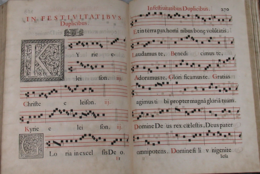
Cantus Fractus Database (Projetto Raphael)
Website: Cantus Fractus
An abiding problem in chant research is the evaluation of rhythm and proportion. This website (in Italian) by Marco Gozzi explores interpretative methods for repertories that are viewable online in early prints and manuscripts. A search form facilitates the retrieval of examples by source location. Excellent leaf-by-leaf viewing tools are provided.
ChantDigger
Website: ChantDigger
The online implementation of Max Haas's lengthy investigation of chant variants is recent. After loading the data one can search either by text or by melody. A "canvas" offers a graph to map chant movement.
Conductus: Online catalogue of poetry and musical settings
Website: Conductus
Mark Everist's conductus cataogue, officially called CPI (Cantus pulcriorem invenire), contains 866 works found in 547 sources (start of 2015(. It facilitates search by title, source, form, style of setting, stanza, poet, language, poetic structure (several subfields), and terminal accent. Sources listed are digitized and viewable online. Cross-listed to DIAMM and RISM.
Fontes Cantus Bohemiae
Website: Fontes Cantus Bohemiae
This collaboration aims to inventory chant sources in Czech regions of Central Europe. Data representing 7,200 chants from the 12th-14th centuries have been uploaded to date in CANTUS-compatible formats.
Hungarian Chant Database
Website: Hungarian Chant Database
This CANTUS-related project stems from the earlier CAO-ECE (Corpus Antiphonalium Officii - Ecclesiarum Centralis Europae) work, which was designed to inventory and compare medieval Central European Office repertories. This undertaking aims to apply similar kinds of studies to variations in elements of the Mass. To that end a series of 14th-16th-century sources from Hungary, Poland, the Czech Republic, and Slovakia have recently been entered. Search may be made by text string, CANTUS number, and other parameters.
Mass Database
Website: http://www.mdb.uni-mainz.de/
Records for c.40,000 settings of the Ordinary of the Mass from 1400 to the present day. In process of migration (March 2014).
Motet Database
Website: Motet Database
Guide to motets and Mass Propers in manuscript and printed sources from the period 1475-1600. 33,000 items, indexed section by section. Excludes Magnificats, Lamentation, canticle and strophic hymns. Extensive scribal and source detail.
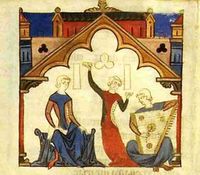
Portuguese Early Music (PEM) Database
Website: Portuguese Early Music Database (PEM)
The Portuguese Early Music Database (PEM) is a model website in that it links Portuguese music manuscript listings with both RISM entries and the CANTUS database. PEM is searchable by genre, feast, and composer. The digital holdings of the Centro de Estudios de Sociologia e Estética Musical consist overwhelmingly of short sacred vocal works found sources that are extremely fragile and therefore well served by digitization. Manuscripts come mainly from the 14th-16th centuries. All sources are reproduced in color. A full listing is here. PEM also maintains a list of links for early sacred-music projects.
Printed Sacred Music Database
Website: Printed Sacred Music Database
This collection of metadata and musical incipits (1500-1800) has been developed over decades under the direction of David Bryant at the Fondazione Giorgio Cini Onlus, Venice, with significant contributions by many individual scholars, and is now served at the Institute of Musicology, University of Fribourg (CH) and implemented by the Swiss RISM office. Search by composers, publishers, musical incipits, and much else. The musical incipits are encoded in DARMS and are rendered in mensural notation.
Medieval Music Database (MMD)
Website:Medieval Music Database

The original database, a model of integrated presentation combined with independent search of text and music fields, was developed by John Stinson and John Griffiths at LaTrobe University (Australia) between 1987 and 1999, when the university's music department was closed. It was maintained over the next five years by the University Library and is still accessible (2014) at the above link. Plans to bring it under the umbrella of DIAMM are under discussion.
One of MMD's great strength, for students of liturgy, is the ability to scroll bilaterally through the temporal and sanctoral cycles, that is by feasts of the Ordinary and those of the Proper. Other supported search fields are text, composer, genre, manuscript, and melody. MMD is cross-referenced to the CAO database.
The musical examples in MMD were produced with Scribe software, also developed by Stinson and Griffiths (c. 1990). It encoded neumes and ligatures (mainly for fourteenth-century music) for printing on a color deskjet printer. It was designed for the DOS operating system and could export to the SCORE music-notation program.
RELICS (Renaissance Liturgical Imprints)
Website: RELICS: A Census
This database, hosted at the University of Michigan, contains entries on c. 14,000 sources of liturgical music printed through the year 1600. Started by David Crawford (1995) and continued by James Borders, the database contains entries from publications in Grance, Germany, and many other European countries. Coverage extends to multiple Roman Catholic rites and to Protestant and Jewish liturgies.
Instrumental Music
Classical String Quartets
Website: Classical String Quartets
Duke University's Classical String Quartets website may not represent the largest collection of this repertory, but it is the largest collection of digitized prints currently accessible online. Its contents are characterized as "rare and unusual" rather than mainstream. If you are looking for variety, consider Förster, Gassmann, Pixis, or Wranitsky (a small sampling of composers represented).
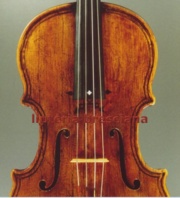
Instrument Makers
Liuteria Bresciana
Website: Brescian Instrument Makers
Brescia was the first home of violin-making. So many of the early makers died in the plague of 1630-31 that Brescia was unable to regain its former glory. It exerted considerable influence on instrument-making in nearby Cremona, which flourished after 1650. Ugo Ravasio's website (Liuteria Bresciana), which covers the period from 1550 into until the eighteenth century, mainly emphasizes the pre-1630 period.
National Music Museum
Website: National Music Museum
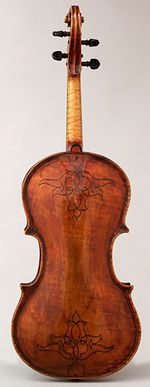
The National Music Museum (Vermilion, South Dakota, US) possesses a highly diverse collection of instruments. It also houses a program on instrument conservation. The main components of the collections are (1) the Witten-Rawlins collection of Northern Italian (Brescian-Cremonese) strings from the seventeenth century, (2) an extensive group of instruments manufactured in the US in the nineteenth and twentieth centuries, and (3) a substantial collection of instruments from other parts of the world. The NMM provides links to many other little-known collections.
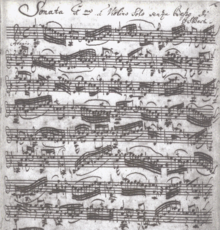
Composer/Theorist Documentation
Bach Digital
Website: Bach Digital
Bach Digital, based in Leipzig, is a one-stop shop for a catalogue of work by J.S. Bach (BWV); of scanned manuscripts; and of a database of manuscripts associated with the Bach family. When complete, it is intended to serve a wide variety of needs of scholars and interests of a wider music audience. An earlier Datenbank der Bach-Quellen (Database of Bach Sources) operates under the auspices of Göttingen's Johann-Sebastian-Bach Institute here.
Beethoven Digital
Website: Beethoven Digital
The Staatsbibliothek in Berlin makes available close-up views of numerous details of the Beethoven's autograph for the Ninth Symphony. This view shows one of the best known passages of the work: Bars 921-922 of the Maestoso movement with the text "Tochter aus Elysium, Freude, schöner Götterfunken!" (Artaria 204(4), f. 124.) A general commentary on the nine symphonies can be found here.
Handel Reference Database
Website: Handel Reference Database
The Handel Reference Database (HRD) provides a continuously updated version of the documentation that accompanied the Stanford doctoral thesis on the reception of the music of G. Fr. Handel by Ilias Chrissochoidis.
Mozart: New Documents
Website: Mozart: New Documents
The aim of this collaborative project, managed by Dexter Edge and David Black, is to bring documentation not reported in musicological literature to public attention. Some items have been retrieved from large repositories of digitized text. A chornological list of posted documents can be found here.
Schenker Documents Online
Website: Schenker Documents Online
Schenker Documents Online (Southampton University) provides a scholarly edition of Heinrich Schenker's correspondence, teaching notes, translations of materials in German, to show the gestation and development of his ideas. It concentrates on the period 1925-1930.
Franz Schubert
Website: Schubert Online
Schubert Online offers combined access to a total of 555 autograph scores, letters, and other documentation on Schubert. Much of the work was facilitated by the Vienna Science and Technology Fund [WWTF or Wiener Wissenschafts-, Forschungs- und Technologiefonds]. The holdings covered come from Vienna's City Hall [Rathaus], the Austrian National Library, the State Library of Berlin, and the National Library of Norway, with intellectual contributions from the Music and Psychology program in Cologne and the Musicology Institute at the University of Vienna. Full-text search is supported for the letters. Deutsch Numbers are used for the music manuscripts. In most cases copies of manuscripts must be ordered from the holding library.
Ludwig Senfl: Works
Website: Senfl Online
The most important composer in Bavaria in the first half of the sixteenth century, Ludwig Senfl (c. 1490-1543) spent almost all his life in the Munich court chapel, first as choirboy, then as musician and composer. Polyphonic incipits in mensural notation are among the items that can be retrieved by genre, voicing, and so forth. Cross-linked to DIAMM.
Giuseppe Verdi: Correspondence
Website: Verdi Correspondence (Braidense Library)
This collection of letters (1838-1883) especially concerns the countess Clara Maffei and Verdi's wife, Giuseppina Strepponi. It was placed online for the Verdi centenary in 2013 by the Braidense National Library in Milan.
Ricordi Historical Archives
Website: Verdi Correspondence and Memorabilia
This great bulk of items in this miscellany (1786 of 2092), which includes corrspondence, scenery designs, pertains to Verdi and his dealings with Giovanni, Tito, and Giulio Ricordi, deals with librettists, casting, staging, and other production details, 1849-1893. One letter (1897) is from Giacomo Puccini.
Digitized Manuscripts and Early Printed Music
Danish National Digital Sheet Music Archive
Website: Danish National Digital Sheet Music Archive
The Danish National Digital Sheet Music Archive is a model operation. Note the frame at the left, which identifies all digitized music; a special collection for flute; another for guitar; and the entire Carl Nielsen Edition available for download. Although Danish music is well served, the site includes a great deal more, including eighteenth-century manuscript, standard repertory in high-quality late nineteenth-century prints, and a special theater collection (libretti et al.).
Early Music Online
Website: Early Music Online
Early Music Online is a digital repository of music in printed anthologies principally from the sixteenth century. Based on holdings in the British Library and related to one series of RISM listings, the digitized volumes of EMO include madrigals, sacred songs, music "concerted by voices and instruments," and pedagogical works.
National Library of Scotland
Website: National Library of Scotland
These digitized sources provide access to digitized copies of the Inglis collection of printed music, memoirs, lyrics to Scottish folksongs, musical magazines, and Scottish keyboard music.
Singakademie Music Archives
Website: Singakademie Music Archives
The collection of mainly eighteenth-century vocal music belonging to Berlin's Singakademie since the time of Karl Friedrich Zelter was long dislodged by twentieth-century wars and politics. The institution's history is the focus of a project to digitize letters, documents, and materials on which prospective applications were tested. The Singakademie is also a participant in the Bach Digital and other projects related to music and musical culture of the eighteenth and nineteenth centuries.
Online Thematic Catalogues and Indices
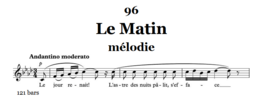
The Bizet Catalogue
Website: The Bizet Catalogue
Every repertory has idiosyncracies that make the adoption of a standard template ill-advised. Hugh Macdonald's Bizet Catalogue shows one of Bizet's idiosyncracies through a listing of the composer's transcriptions of works by others (Gounod, Mozart, Saint-Saëns, et al.). The primary listing of works gives folio-by-folio detail of manuscripts for longer works with texts of underlying verses and notes on their authors, citations of self-borrowings, and much else.
Benjamin Britten Thematic Catalogue
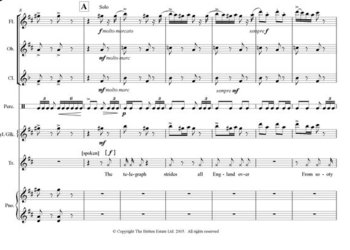
Website: Benjamin Britten Thematic Catalogue
The Britten Thematic Catalogue, an online only project based at the Britten-Pears Foundation, provides multiple access points for searching. Britten's career was extremely wide-ranging. His arrangements of music by Henry Purcell (54 titles) and of British folksongs (74 titles) filled much of his time in the 1940s and early '50s. The full gamut stretches from chamber music (134 items) mainly from the 1920s to his stage work Death in Venice (1973). Each work contains a detailed index with a graphical display and sound files.
Frescobaldi Thematic Catalogue Online
Website: Frescobaldi Thematic Catalogue Online
This database has a multi-faceted search interface. It is cross-linked to RISM IDs and has detailed source listings. (Content tends to vary slightly by source.) The general time-frame indicator gives a sense of the long tradition of recopying that followed the composer's works. Links to printed commentaries and modern editions are provided. Currently 906 works are included.
Catalogue of Carl Nielsen's Works
Website: Catalogue of Carl Nielsen's Works
The Danish National Library has prepared this online catalogue of 414 pieces, including operas, symphonies, and concertos plus vocal, choral, and chamber pieces. Each entry includes musical incipits, lists of sources and sketches, citations for textual sources, and lists of performances.

In association with the Nielsen Catalogue, implemented by Axel Teich Geertinger, an editing tool for metadata used in similar projects has been developed by Sigfrid Lundberg and can be downloaded from GitHub. Based on MEI, the foundation of MerMEId was laid by Kristine Richts and Maya Hartwig. Further details about MerMEId and a sample implementation can be found at this site.
Ethnomusicology

Images, sound files, and videos on the internet offer great scope for ethnomusicological study, but much of the material is limited to poorly documented materials with arbitrary labels. Only selected sites can be included here.
UNC Middle Eastern Music

Website: Middle Eastern Music
The University of North Carolina offers top-down collections of selected repertories from Egyptian, Turkish, Iraqi, and classical Persian music. Each site varies from the others. Explanatory material concerning composers, instruments, styles, and cultural emphases are general to most. The Farabi site also discusses theoretical concepts in Persian classical music. The Turkish one contains many sound examples.
Digital Image Archives
Digital Image Archive of Medieval Music
Website: Digital Image Archive of Medieval Music (DIAMM)
Originally a site for viewing images of rare manuscripts at various levels of resolution, DIAMM is increasingly an umbrella site for diverse projects in medieval music. The core textual database is organized by source location. Registered users may add their own comments about individual works. List and faceted search capabilities are currently being added. It now includes an online teaching resource for musicians wishing to learn more about the notation of medieval music. Register at http://diamm.nsms.ox.ac.uk/moodle/.
Emblematica Online
Website: Emblematica Online
This umbrella project serves a growing number of library-based projects, which are here cited individually. Emblem books are rich resources for those interested in decoding visual information in early printed materials. The collective site currently (April 2014) lists 636 emblem books. Searches by title, text, and image are supported. There are two component parts. (1) The Herzog August Bibliothek (HAB) Emblem Books and (2) the University of Illinois Emblem Books.
The first makes available 636 emblems books, principally from the 17th and 18th centuries. It represents only a tiny fraction of the rich holdings of the Herzog August Bibliothek in Wolffenbüttel, which is particularly rich in seventeenth-century materials. August the Younger developed a three-tiered description system still in use today. Two noted figures--G. W. Leibniz (1691-1716) and G. E. Lessing (1770-1781) were later librarians. German materials are prevalent in the Illinois collection (as well as the German one).
Additional digitized emblem books from Duke University, the Getty Library, Glasgow University, and the University of Utrecht are in course of being uploaded. Each has a separate search page.
French Emblems at Glasgow
Website: French Emblems at Glasgow
This site hosts 27 browsable emblem books associated with 16th-century France. Eack book islinked to an alphabetical listing by author that enables rapid exploration. Some sources are bilaterally in Latin. A smaller collection of Italian emblem books is also held.
Rare Music Manuscripts in the British Library
Website: Rare Music Manuscripts in the British Library
See the Old Hall manuscript, Purcell's coronation anthem for James II, an excerpt from Handel's Messiah, Bach's autograph for Book Two of the Well-Tempered Clavier, Mozart's thematic catalogue of his composition, Beethoven's sketches for the Sixth Symphony ("Pastoral"), and much else. (Music manscripts make up just one part of the holdings viewable at this portal.)
Musica Sacra
Website: Musica Sacra
Notable collection of scanned chant books at http://musicasacra.com/music/ and http://musicasacra.com/resource-lists/. Includes the Liber Usualis and many other resources for modern use in traditional settings.
Resources for Chronology
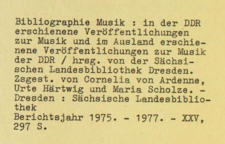
Music Bibliography in the German Democratic Republic
Website: Annual Music Bibliographies in the German Democratic Republic
Music Bibliography in the German Democratic Republic (Deutsche Demokratische Republik or DDR, 1949-1990) is an idiosyncratic subject but one which those engaged in music history of the second half of the twentieth century may find compelling. The illustration accompanying this entry shows the full title of a typescript catalogue of new works (scores, writings on music theory, books, articles, and much miscellany) for the year 1975. This item can be found here.
Hofmeister XIX
Website: Hofmeister XIX
Database of 330,000 records from the Hofmeister Monatsberichte, 1829-1900, listing music publications of the period. Compiled by Friedrich Hofmeister and published in Leipzig by Breitkopf & Härtel. Well indexed for quick searches.
Libretto Portals
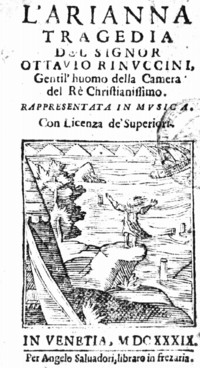
Corniani-Algarotti Collection
Website: Corniani-Algarotti Libretto Collection
Although the search form shows only four fields, the name field (nome) will accept almost any proper noun (surname of composer, librettist, scenographer, city, theater, etc.). Most sources are digitized and downloadable. This collection holds 9,000 libretti (in Italian) from the sixteenth through the nineteenth centuries. Some were published and used outside Italy. Most texts were for operas, but oratorio, cantata, and serenata texts can also be found.
VifaMusik Libretto Portal
Website: http://libretti.digitale-sammlungen.de/de/fs1/start/static.html ViFaMusik Libretto Portal
The new (2014) VifaMusik Libretto Portal searches across component collections held in the Bavarian State Library (5600 items), the Frankfurt University Library, and the Library of the German Institute in Rome (1500 titles). One can search by composer, librettist, and so forth. Since the term libretto referred to any small book, texts for oratorios, cantatas, serenatas, ballets, and so forth occur in some of the constituent collections.
Index to Opera and Ballet Sources Online
Website: Index to Opera and Ballet Sources Online
This title index for individual works relies on aggregators (the Braidense Raccolta Drammatica, ViFaMusik, the Internet Culturale, et al.) for most of its contents. Since it does not distinguish between different versions of single titles, those with an acute interest in a defined topic may still wish to consult the aggregations. It relies on five data fields: title, composer, genre, format, and date. Its principal holdings are libretti. Some links to scores can also be found. The advance search tool at atom.lib.byu.edu/opbs/advanced allows one to search with individual aggregations.
Digitized Music Bibliographies
Eitner's Quellen-Lexikon
Website: Eitner's Quellen-Lexikon
Robert Eitner's Quellen-Lexikon, published by Breitkopf & Härtel between 1900 nand 1904, was the Bible for generations of scholars seeking to determine which libraries held surviving manuscripts of music from the sixteenth and seventeenth centuries. Although a portion of these sources are gradually finding their way online, Eitner remains an invaluable record of what sources existed before 1914. The scanned material was proofreading and corrected prior to posting. This site is hosted by the Musicology Institute of the University of Zurich.